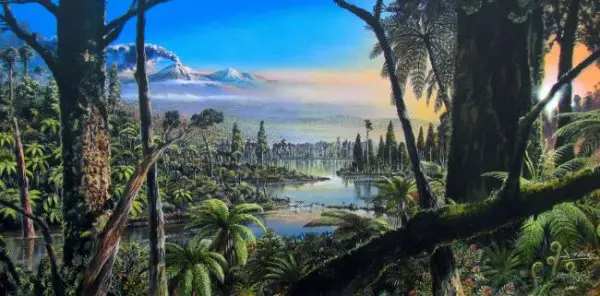Researchers Find Undersea Evidence Of Rainforests In Antarctica
Tags: News

An illustration of the temperate rainforest that thrived in West Antarctica about 90 million years ago, when dinosaurs still walked the Earth.
A research team has uncovered evidence in a West Antarctica seabed which implicates the existence of rainforests some 90 million years ago.
The Antarctica forests are thought to have been similar to those found today on New Zealand’s South Island.
From aboard a polar vessel, the researchers drilled into the Amundsen seafloor between February and March of 2017.
The information which were derived from the sediment core samples which were extracted in the vicinity of Pine Island and the Thwaites glaciers, were published in the Nature journal this week.
The specimens were estimated to be 90 million years old. That’s from the Cretaceous period and falls within the dinosaur age. Despite being found in the seafloor, there was clear evidence of land.
Pristine samples of forest soil, spores and well preserved root systems were uncovered by the UK and German scientists.
Included in the soil sample was pollen. The pollen is believed to have originated from what would be the closest flowering plants ever found near the South Pole.
A much warmer Antarctica climate
The sediment cores also revealed a lot about climate, temperature, rainfall and vegetation.
Professor Tina van de Flierdt, of the department of earth science and engineering at Imperial College London, said: “The preservation of this 90 million-year-old forest is exceptional, but even more surprising is the world it reveals.
“Even during months of darkness, swampy temperate rainforests were able to grow close to the South Pole, revealing an even warmer climate than we expected.”
The findings included:
– The average daytime temperature was 12 degrees Celsius (°C). By comparison, today’s annual mean temperature in Antarctica is −57 °C inland and −10 °C on the coast.
– The sea level was 170 meters higher than it is today.
– Average rainfall was about 246 centimeters – similar to what Wales experiences at present.
– Instead of the ice caps we see today, West Antarctica’s coast contained swamps, river and rainforest.
How did rainforests grow in the dark of Antarctica?
The answer to that lies in carbon dioxide.
As is the case today, a four-month polar night would have existed 90 million years ago.
As we know, carbon dioxide creates a greenhouse effect by trapping heat from the sun.
And based on existing climate models, the researchers discovered that the atmospheric carbon dioxide level was much higher than expected.
This factor – combined with an ice sheet-less Antarctica covered with vegetation – formed the conditions needed for a rainforest to thrive.
Read more: Koalas Rescued From Australian Fires Have Been Released Back Into Nature
Image Credit: © J. McKay/Alfred-Wegener-Institut;
Leave Comment: